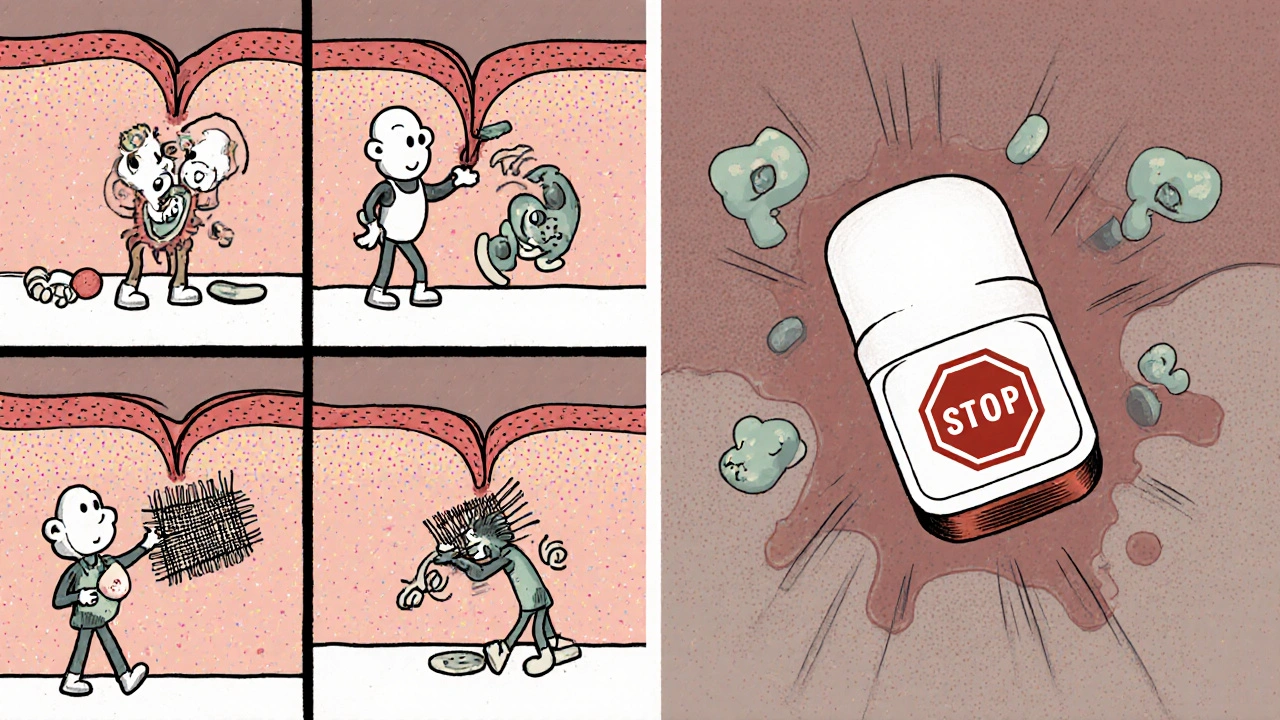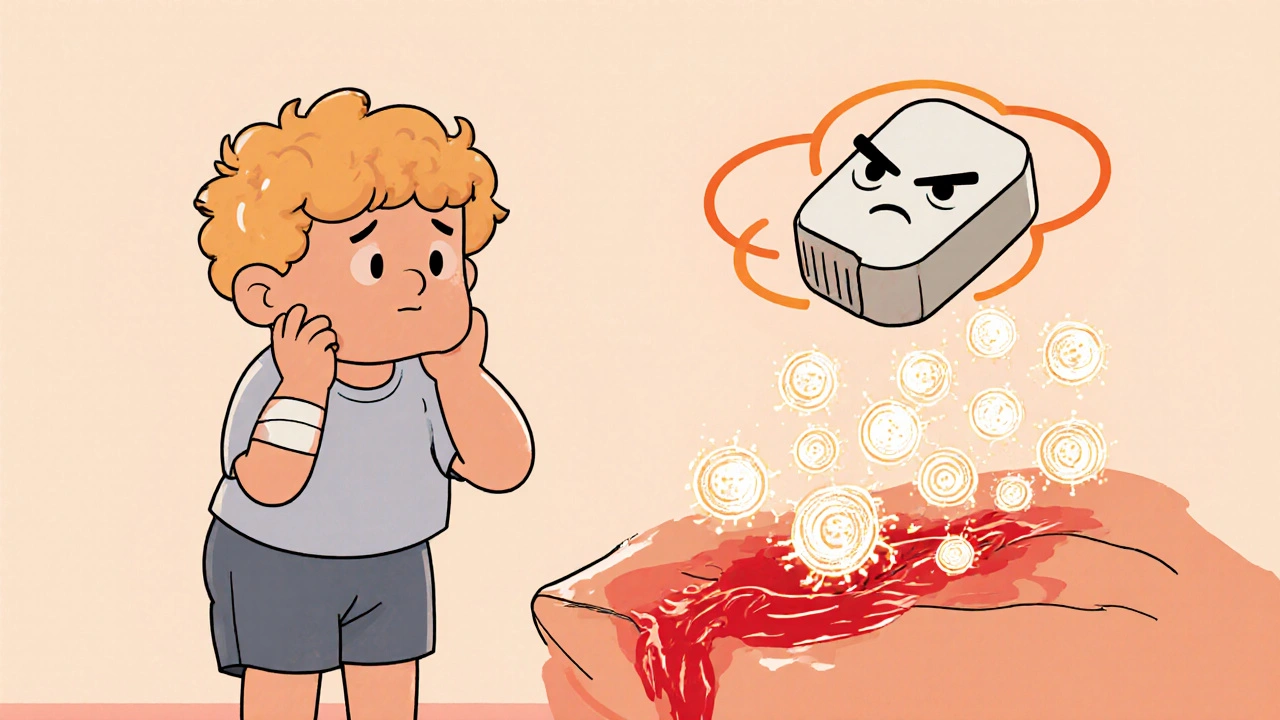When you cut your finger or get a scrape, the last thing you want is for it to take weeks to heal. Many people reach for aspirin at the first sign of pain, hoping it will help the wound close faster. But does aspirin actually speed up wound healing-or could it be making things worse?
What aspirin does to your body
Aspirin, or acetylsalicylic acid, is a nonsteroidal anti-inflammatory drug (NSAID). It works by blocking enzymes called COX-1 and COX-2. These enzymes produce prostaglandins, chemicals that cause pain, fever, and inflammation. By reducing prostaglandins, aspirin lowers pain and swelling. That’s why it’s used for headaches, arthritis, and heart attack prevention.
But inflammation isn’t always bad. In the early stages of wound healing, inflammation is a necessary part of the process. It brings white blood cells to the site to fight infection and clear out damaged tissue. If you suppress that too early or too much, you might be slowing down healing instead of helping it.
How wounds heal-step by step
Wound healing happens in four clear phases:
- Haemostasis: Blood vessels constrict, and platelets form a clot to stop bleeding.
- Inflammation: Immune cells rush in to remove debris and bacteria. This phase causes redness, warmth, and swelling.
- Proliferation: New tissue forms. Fibroblasts make collagen, and new blood vessels grow.
- Remodeling: The wound strengthens as collagen reorganizes over weeks or months.
Aspirin interferes most with the first two phases. It reduces platelet activity, which can delay clotting. It also dampens the inflammatory response. While this sounds good for reducing pain, it can mean slower tissue repair.
What research says about aspirin and healing
A 2021 study in the Journal of Surgical Research looked at 120 patients with minor surgical wounds. Half took 81 mg of aspirin daily; the other half didn’t. After 14 days, the aspirin group had 22% slower re-epithelialization-the process where new skin covers the wound. The difference was most noticeable in diabetic patients, whose healing is already compromised.
Another study from the University of Pennsylvania found that aspirin reduced collagen production by up to 30% in lab-grown skin cells. Collagen is the main structural protein in skin. Less collagen means weaker new tissue and a higher risk of reopening the wound.
Even low-dose aspirin (81 mg), often taken for heart health, has been linked to prolonged healing times in clinical trials. It doesn’t stop healing completely-but it does slow it down.

When aspirin might help-rare cases
There’s one exception: chronic, inflamed wounds that aren’t healing because of excessive swelling. In rare cases, doctors may use low-dose aspirin in patients with venous ulcers or severe pressure sores where inflammation is the main barrier to healing. But this is done under strict medical supervision, not as a DIY fix.
For most people with cuts, scrapes, or minor burns, aspirin isn’t the right tool. It doesn’t kill bacteria. It doesn’t moisturize. It doesn’t stimulate cell growth. It just reduces pain and swelling-and sometimes that’s more harmful than helpful.
What actually helps wounds heal faster
If you want to speed up recovery, skip the aspirin and focus on what really works:
- Clean the wound: Rinse with clean water and mild soap. Don’t use hydrogen peroxide or alcohol-they damage new cells.
- Keep it moist: Use petroleum jelly or a simple antibiotic ointment. Moist wounds heal 40% faster than dry ones, according to the American Academy of Dermatology.
- Cover it: Use a sterile bandage. Change it daily or when it gets wet.
- Elevate and rest: Less movement means less stress on the healing tissue.
- Get enough protein and vitamin C: Your body needs these to build new skin. Eggs, chicken, citrus, and bell peppers help.
For pain relief, acetaminophen (Tylenol) is a better choice than aspirin. It doesn’t affect platelets or inflammation the same way. It reduces pain without interfering with the healing process.

Who should avoid aspirin entirely
Even if you’re not worried about wounds, aspirin isn’t safe for everyone:
- Children and teens under 18-risk of Reye’s syndrome, a rare but deadly condition.
- People with stomach ulcers or bleeding disorders-aspirin increases bleeding risk.
- Pregnant women, especially in the third trimester-it can affect fetal circulation.
- Those on blood thinners like warfarin-combining them with aspirin raises bleeding risk.
If you’re taking aspirin daily for heart health and you get a wound, don’t stop it without talking to your doctor. But do monitor the healing closely. If the wound looks red, swollen, or doesn’t improve after 5 days, see a healthcare provider.
Bottom line: Don’t use aspirin for wound healing
Aspirin isn’t a magic pill for faster recovery. It’s a painkiller and anti-inflammatory-but in wound healing, inflammation is a helper, not the enemy. Slowing it down can delay recovery, increase infection risk, and weaken new tissue.
If you need pain relief after an injury, choose acetaminophen. Focus on clean, moist, covered wounds. Eat well. Rest. Give your body what it needs to fix itself.
Aspirin has its place-for headaches, heart protection, and reducing fever. But when it comes to healing cuts and scrapes, leave it in the cabinet. Your skin will thank you.
Can aspirin prevent infection in wounds?
No, aspirin doesn’t kill bacteria or prevent infection. It only reduces pain and inflammation. For infection prevention, clean the wound properly and use an antibiotic ointment if needed. Relying on aspirin for infection control can lead to complications.
Is it safe to take aspirin for a bruise or swelling?
For minor bruising or swelling from a bump or sprain, aspirin can help reduce discomfort. But if the injury involves broken skin, avoid aspirin. The same anti-clotting effect that helps with swelling can also increase bleeding under the skin, making the bruise larger or slower to fade.
Does topical aspirin help wounds heal faster?
There’s no reliable evidence that applying aspirin directly to a wound helps. Crushed aspirin on a cut can irritate the skin and cause chemical burns. The body needs systemic absorption for aspirin to work, and topical use doesn’t deliver enough to affect healing-only to cause harm.
How long does a small cut take to heal without aspirin?
A small, clean cut on healthy skin usually heals in 5 to 7 days. Deeper or larger cuts may take 10 to 14 days. Keeping the wound moist and covered can shorten that time. Aspirin can add 2 to 5 extra days to healing, especially in older adults or those with diabetes.
What’s the best painkiller for wound pain?
Acetaminophen (Tylenol) is the safest choice. It relieves pain without affecting platelets or inflammation. NSAIDs like ibuprofen or naproxen also slow healing, so they’re not ideal either. For mild pain, cold compresses and elevation often work better than pills.


Rebecca Parkos
Wow, I’ve been popping aspirin for every little scrape since I was a kid. This is a total wake-up call. My last cut took forever to heal and I thought it was just me being clumsy. Turns out I was sabotaging myself. Thanks for this.
Bradley Mulliner
Of course aspirin slows healing. You’re literally poisoning your body’s natural defense system. People think medicine = fix, but biology doesn’t work like a remote control. Stop treating inflammation like a villain-it’s your body’s firefighter. And no, you don’t get a medal for ignoring science.
Rahul hossain
Interesting. In India, we use turmeric paste on wounds-natural, anti-inflammatory, and no side effects. Aspirin is a Western crutch. We heal faster with kitchen spices than with lab-made chemicals. Maybe the problem isn’t just aspirin-it’s our obsession with pharmaceuticals.
Reginald Maarten
Technically, aspirin inhibits cyclooxygenase-1, which reduces thromboxane A2 synthesis-thereby impairing platelet aggregation. This is well-documented in the literature. The claim that it ‘delays re-epithelialization’ is corroborated by multiple RCTs, including the 2021 study cited. However, the effect size is modest in healthy adults under 40. The real issue is overgeneralization: conflating minor cuts with surgical wounds. Context matters.
Robin Annison
It’s funny how we’ve turned our bodies into machines we can tweak with pills. We forget that healing isn’t a problem to be solved-it’s a process to be honored. The inflammation we hate? That’s life rebuilding itself. Maybe the real question isn’t whether aspirin helps-but whether we’ve lost the patience to let our bodies do their job.
Abigail Jubb
I’ve been using aspirin for years. I just found out I’ve been making my scars worse. I’m devastated. My hand still looks like a crime scene. I thought I was being responsible. Turns out I was just… ignorant. And now I’m scared to even get a paper cut. What if I’ve ruined my skin forever?
George Clark-Roden
There’s a quiet poetry in the body’s healing process-blood clotting like ink on paper, inflammation as the whisper of immune soldiers marching in, collagen weaving like a spider’s silk. Aspirin? It’s like turning off the lights in the middle of a symphony because you don’t like the volume. We’ve forgotten that pain isn’t the enemy-it’s the messenger. And sometimes, the most healing thing you can do… is do nothing.
Hope NewYork
so like… aspirin = bad for cuts? lol i thought it was magic. i just crush it and put it on my zits too. wait noooooo?? now my skin is gonna be ruined forever?? i’m so mad at my mom for never telling me this. also why is tylenol better?? isn’t it just poison too??
Bonnie Sanders Bartlett
This is such a clear, thoughtful breakdown. I’ve shared this with my whole family. My dad’s been on low-dose aspirin for years and had a cut that wouldn’t heal. Now he’s talking to his doctor. Knowledge like this saves people from unnecessary suffering. Thank you for writing it.
Nishigandha Kanurkar
Aspirin is a government tool to make you dependent. The pharmaceutical industry doesn’t want you healing naturally-they want you buying pills forever. Turmeric, honey, and rest? They can’t patent that. This article? Probably funded by Tylenol. Watch your back.
Iván Maceda
🇺🇸 We don’t need fancy science to know what works. Clean it. Cover it. Let it breathe. Aspirin? That’s for weaklings who can’t handle a little pain. Real Americans heal fast-no pills needed. 💪
Vrinda Bali
It is regrettable that modern medicine has become so reductionist. The human body is not a machine to be optimized with chemical interventions. Traditional systems of medicine-Ayurveda, Traditional Chinese Medicine-have long recognized inflammation as a vital, constructive force. To suppress it casually is not merely unscientific; it is culturally arrogant.
John Rendek
Good info. Clean, cover, keep moist. That’s it. No magic pills. Just basic care. And if you’re on aspirin for your heart, don’t panic-just watch the wound. Talk to your doc. Simple.
Sonia Festa
Man, I used to think aspirin was the Swiss Army knife of medicine. Turns out it’s more like a hammer trying to fix a watch. I’ll stick to honey on my scrapes now-sweet, sticky, and actually kinda nice. Who knew healing could feel like a hug?